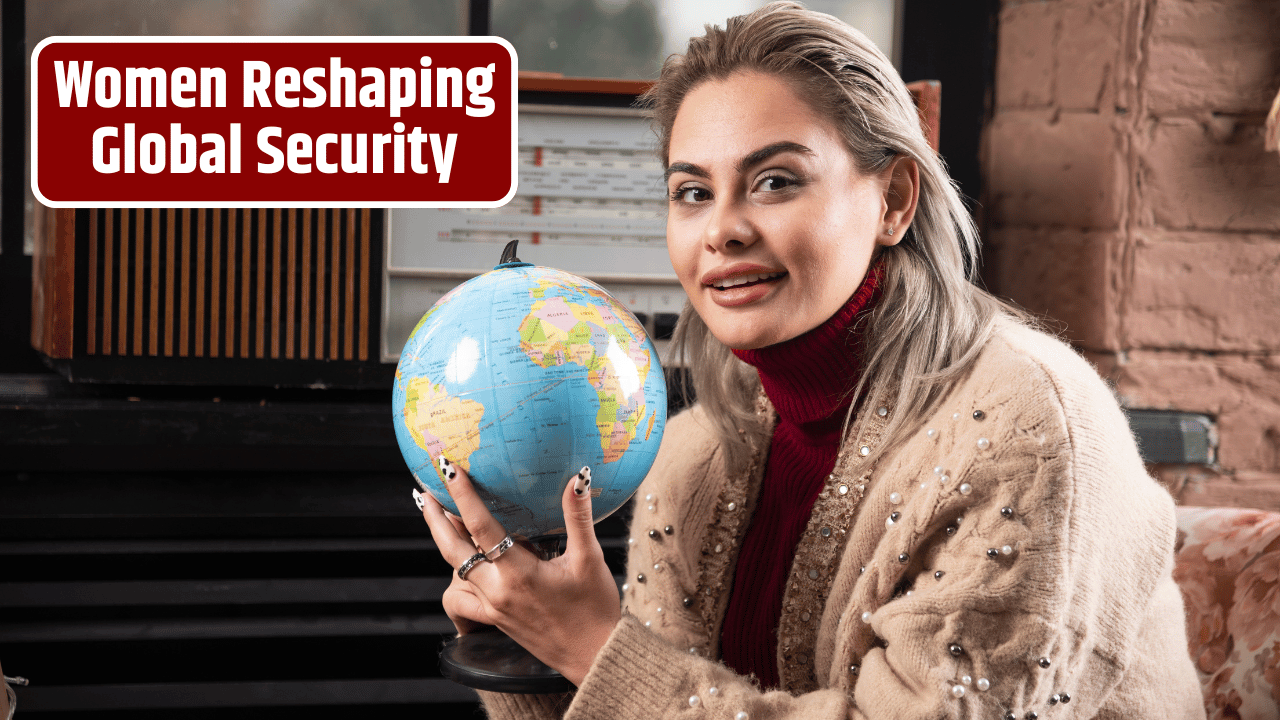She’s not holding a rifle, but she’s holding the line. Not standing in a war room, but standing in a courtroom, a clinic, a checkpoint, a burned-out school — wherever she’s needed.
And make no mistake — she’s changing the game.
For decades, global security was treated like a boys’ club: generals, arms deals, “hard power.” You know the drill. Women? If they were mentioned at all, it was usually as civilians in need of “protection.”
But that’s old news.
The new reality? Women are not just in the conversation — they’re shaping it.
From the U.S. military to peace negotiations in Yemen, from cyber defense units to counterterrorism teams in the Sahel — women are now at the frontlines of global security, not as footnotes, but as architects of what security actually means in the 21st century.
Table of Contents
Security Isn’t Just Bombs and Borders Anymore
First, let’s rethink the whole “security” thing.
The old-school idea was this: protect the state from external threats — mostly through military might.
But that model’s failing. Repeatedly.
What we’re seeing now is a shift toward human security — where protecting people means access to education, freedom from gender-based violence, stable economies, and functioning institutions. And who’s leading that shift?
Yep. Women.
Because they know that safety isn’t just about stopping bullets. It’s about stopping child marriages. It’s about rebuilding trust after ethnic cleansing. It’s about making sure girls can go to school without getting acid thrown at them.
Security isn’t just defense. It’s defending dignity.
Where Women Are Making a Direct Impact
Let’s map it out. Across the world, women are stepping into spaces once reserved for men with uniforms and national flags — and flipping the script.
In Peacekeeping Forces
- Over 120 countries now have women deployed in UN peacekeeping missions.
- In countries like Rwanda and Bangladesh, female peacekeepers have proven critical in community trust-building and protecting women from violence.
- Female officers are more likely to receive reports of sexual violence and less likely to escalate conflict.
In Intelligence & Cybersecurity
- In the U.S. and Israel, women are leading cyber defense units and innovating strategies for counter-disinformation.
- In Nigeria, women-led security teams have tracked Boko Haram movements using community networks.
- In Ukraine, female cyber analysts are playing key roles in defending digital infrastructure against Russian attacks.
In Negotiation Rooms
- Women were instrumental in Colombia’s peace process, ensuring gender-based violence was acknowledged in the final accord.
- In the Philippines, Miriam Coronel-Ferrer became the first woman in the world to sign a major peace accord as chief negotiator.
- In Afghanistan, even as the Taliban tightens control, women continue to demand representation in exile-led resistance efforts.
| Area | Women’s Role | Result/Impact |
|---|---|---|
| UN Peacekeeping | Military, police, and community engagement | Higher trust levels in local populations |
| Cybersecurity | Cyber defense, misinformation monitoring | Improved early threat detection |
| Peace Negotiations | Mediators, negotiators, legal advisors | Broader, more inclusive agreements |
| Community Defense | Local watch groups, conflict resolution leaders | Reduced local violence, stronger ties |
| Intelligence | Analysts, risk assessors, field agents | Better early-warning and human-focused strategies |
The “Female Security Premium”
Let’s put it bluntly: when women are in charge of security decisions, communities are safer.
It’s not magic. It’s that women often bring:
- Lower tolerance for collateral damage
- Stronger community networks
- Holistic threat assessments that include public health, infrastructure, and family welfare
- Empathy-based leadership, which, in post-conflict zones, is not soft — it’s strategic
This isn’t just idealism. It’s good strategy.
In fact, a McKinsey study showed that inclusive security policies lead to better governance, reduced risk of violence relapse, and longer-lasting peace.
So Why Are Women Still Missing From the Picture?
Here’s the frustrating part: despite overwhelming evidence that women improve peace and security outcomes, they’re still woefully underrepresented in formal decision-making.
- Women make up only 6% of mediators in major peace processes.
- Only 19 countries have ever had female defense ministers.
- In conflict-affected countries, women’s participation in security sector reform is often under 10%.
Why? Because power structures are sticky. And deeply patriarchal.
Because warlords and strongmen don’t want to share the table — much less the microphone.
Because even in progressive nations, women’s expertise is dismissed or overlooked.
But the Tide’s Turning — Fast
Thanks to global movements like UNSCR 1325 (Women, Peace & Security) and the increasing visibility of women-led peace successes, things are shifting.
International funding bodies are prioritizing gender-inclusive programs.
Regional coalitions — especially in Africa and Latin America — are training and elevating women leaders in security and defense.
And most importantly, younger generations of women are stepping into these roles without apology.
They’re not asking, “Can I be at the table?”
They’re asking, “Why is this table still full of guys who started the wars we’re trying to end?”
FAQs
Isn’t security too “technical” or “military” for grassroots women to engage in?
That’s outdated thinking. Women bring critical expertise — from community intelligence to trauma-informed peacebuilding — that traditional security actors often miss.
Don’t women in frontline security face more danger?
Yes — including threats from both enemies and within their own forces. Which is why protection, policy reform, and accountability mechanisms are vital.
Are women just in support roles, or actual decision-makers?
Both — but we need more in decision-making roles. They’ve proven their impact across ranks and disciplines, and now it’s about scaling that leadership.
What are governments doing to include more women?
Some, like Canada and Norway, have gender-focused foreign policies. Others are lagging. It’s a patchwork — but growing pressure is forcing change.














